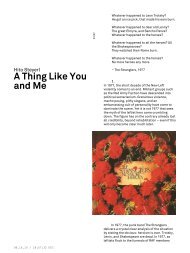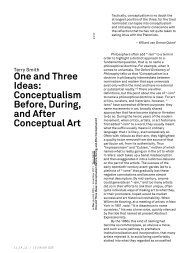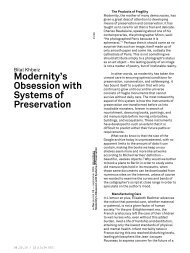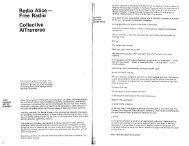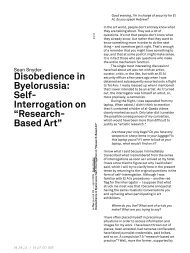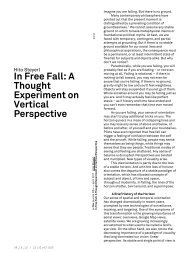In Defense of the Poor Image - e-flux Layout Generator
In Defense of the Poor Image - e-flux Layout Generator
In Defense of the Poor Image - e-flux Layout Generator
You also want an ePaper? Increase the reach of your titles
YUMPU automatically turns print PDFs into web optimized ePapers that Google loves.
The poor image thus constructs anonymous<br />
global networks just as it creates a shared<br />
history. It builds alliances as it travels, provokes<br />
translation or mistranslation, and creates new<br />
publics and debates. By losing its visual<br />
substance it recovers some <strong>of</strong> its political punch<br />
and creates a new aura around it. This aura is no<br />
longer based on <strong>the</strong> permanence <strong>of</strong> <strong>the</strong><br />
“original,” but on <strong>the</strong> transience <strong>of</strong> <strong>the</strong> copy. It is<br />
no longer anchored within a classical public<br />
sphere mediated and supported by <strong>the</strong> frame <strong>of</strong><br />
<strong>the</strong> nation state or corporation, but floats on <strong>the</strong><br />
surface <strong>of</strong> temporary and dubious data pools. 15<br />
By drifting away from <strong>the</strong> vaults <strong>of</strong> cinema, it is<br />
propelled onto new and ephemeral screens<br />
stitched toge<strong>the</strong>r by <strong>the</strong> desires <strong>of</strong> dispersed<br />
spectators.<br />
The circulation <strong>of</strong> poor images thus creates<br />
“visual bonds,” as Dziga Vertov once called<br />
<strong>the</strong>m. 16 This “visual bond” was, according to<br />
Vertov, supposed to link <strong>the</strong> workers <strong>of</strong> <strong>the</strong> world<br />
with each o<strong>the</strong>r. 17 He imagined a sort <strong>of</strong><br />
communist, visual, Adamic language that could<br />
not only inform or entertain, but also organize its<br />
viewers. <strong>In</strong> a sense, his dream has come true, if<br />
mostly under <strong>the</strong> rule <strong>of</strong> a global information<br />
capitalism whose audiences are linked almost in<br />
a physical sense by mutual excitement, affective<br />
attunement, and anxiety.<br />
But <strong>the</strong>re is also <strong>the</strong> circulation and<br />
production <strong>of</strong> poor images based on cell phone<br />
cameras, home computers, and unconventional<br />
forms <strong>of</strong> distribution. Its optical connections –<br />
collective editing, file sharing, or grassroots<br />
distribution circuits – reveal erratic and<br />
coincidental links between producers<br />
everywhere, which simultaneously constitute<br />
dispersed audiences.<br />
The circulation <strong>of</strong> poor images feeds into<br />
both capitalist media assembly lines and<br />
alternative audiovisual economies. <strong>In</strong> addition to<br />
a lot <strong>of</strong> confusion and stupefaction, it also<br />
possibly creates disruptive movements <strong>of</strong><br />
thought and affect. The circulation <strong>of</strong> poor<br />
images thus initiates ano<strong>the</strong>r chapter in <strong>the</strong><br />
historical genealogy <strong>of</strong> nonconformist<br />
information circuits: Vertov’s “visual bonds,” <strong>the</strong><br />
internationalist workers pedagogies that Peter<br />
Weiss described in The Aes<strong>the</strong>tics <strong>of</strong> Resistance,<br />
<strong>the</strong> circuits <strong>of</strong> Third Cinema and<br />
Tricontinentalism, <strong>of</strong> non-aligned filmmaking<br />
and thinking. The poor image – ambivalent as its<br />
status may be – thus takes its place in <strong>the</strong><br />
genealogy <strong>of</strong> carbon-copied pamphlets, cinetrain<br />
agit-prop films, underground video<br />
magazines and o<strong>the</strong>r nonconformist materials,<br />
which aes<strong>the</strong>tically <strong>of</strong>ten used poor materials.<br />
Moreover, it reactualizes many <strong>of</strong> <strong>the</strong> historical<br />
ideas associated with <strong>the</strong>se circuits, among<br />
o<strong>the</strong>rs Vertov’s idea <strong>of</strong> <strong>the</strong> visual bond.<br />
05.11.11 / 11:04:46 EDT<br />
08/09<br />
e-<strong>flux</strong> journal #10 — november 2009 Hito Steyerl<br />
<strong>In</strong> <strong>Defense</strong> <strong>of</strong> <strong>the</strong> <strong>Poor</strong> <strong>Image</strong><br />
Imagine somebody from <strong>the</strong> past with a<br />
beret asking you, “Comrade, what is your visual<br />
bond today?”<br />
You might answer: it is this link to <strong>the</strong><br />
present.<br />
6. Now!<br />
The poor image embodies <strong>the</strong> afterlife <strong>of</strong> many<br />
former masterpieces <strong>of</strong> cinema and video art. It<br />
has been expelled from <strong>the</strong> sheltered paradise<br />
that cinema seems to have once been. 18 After<br />
being kicked out <strong>of</strong> <strong>the</strong> protected and <strong>of</strong>ten<br />
protectionist arena <strong>of</strong> national culture, discarded<br />
from commercial circulation, <strong>the</strong>se works have<br />
become travelers in a digital no-man’s land,<br />
constantly shifting <strong>the</strong>ir resolution and format,<br />
speed and media, sometimes even losing names<br />
and credits along <strong>the</strong> way.<br />
Now many <strong>of</strong> <strong>the</strong>se works are back – as<br />
poor images, I admit. One could <strong>of</strong> course argue<br />
that this is not <strong>the</strong> real thing, but <strong>the</strong>n – please,<br />
anybody – show me this real thing.<br />
The poor image is no longer about <strong>the</strong> real<br />
thing – <strong>the</strong> originary original. <strong>In</strong>stead, it is about<br />
its own real conditions <strong>of</strong> existence: about<br />
swarm circulation, digital dispersion, fractured<br />
and flexible temporalities. It is about defiance<br />
and appropriation just as it is about conformism<br />
and exploitation.<br />
<strong>In</strong> short: it is about reality.<br />
×<br />
An earlier version <strong>of</strong> this text was improvised in a response at<br />
<strong>the</strong> “Essayfilm – Äs<strong>the</strong>tik und Aktualität” conference in<br />
Lüneburg, Germany, organized by Thomas Tode and Sven<br />
Kramer in 2007. The text benefitted tremendously from <strong>the</strong><br />
remarks and comments <strong>of</strong> Third Text guest editor Kodwo<br />
Eshun, who commissioned a longer version for an issue <strong>of</strong><br />
Third Text on Chris Marker and Third Cinema to appear in<br />
2010 (co-edited by Ros Grey). Ano<strong>the</strong>r substantial inspiration<br />
for this text was <strong>the</strong> exhibition “Dispersion” at <strong>the</strong> ICA in<br />
London (curated by Polly Staple in 2008), which included a<br />
brilliant reader edited by Staple and Richard Birkett. The text<br />
also benefitted greatly from Brian Kuan Wood’s editorial<br />
work.



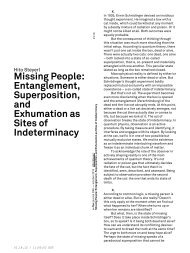
![Comrades of Time [PDF] - weskline . com](https://img.yumpu.com/50148218/1/190x253/comrades-of-time-pdf-weskline-com.jpg?quality=85)
